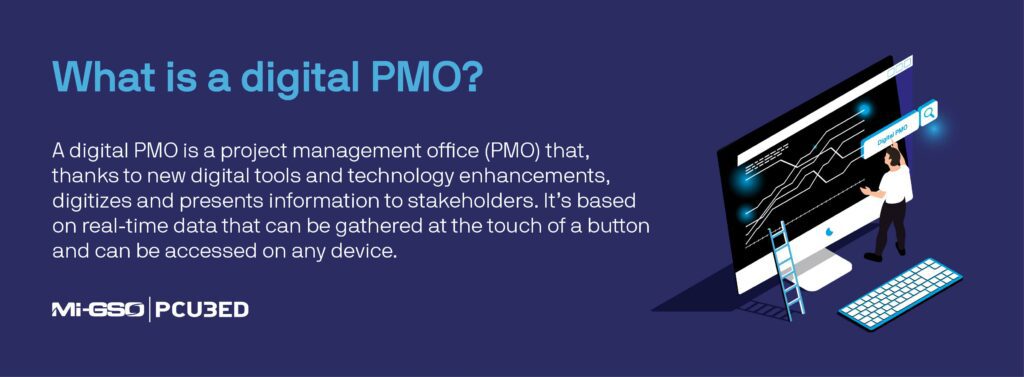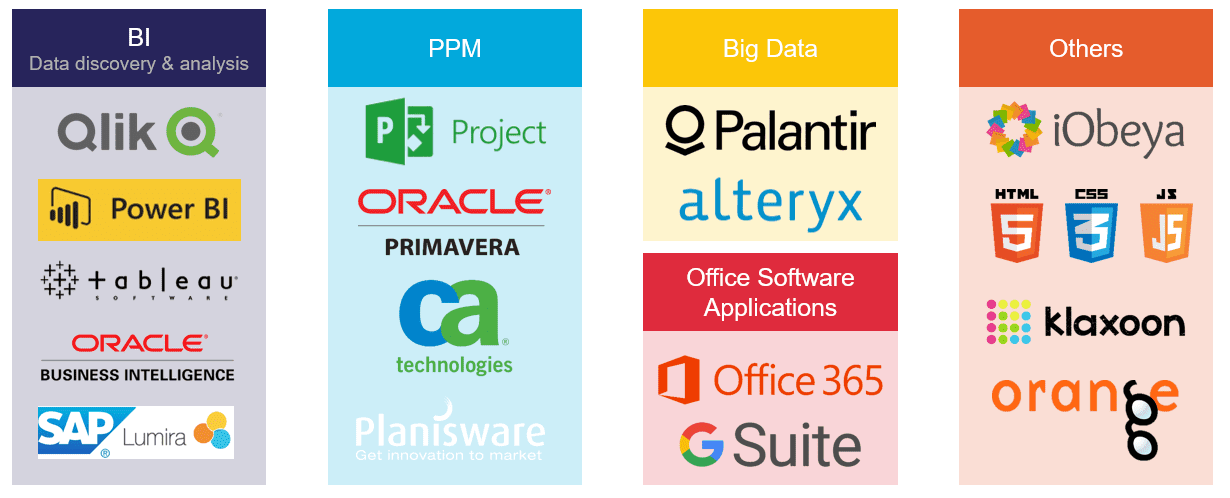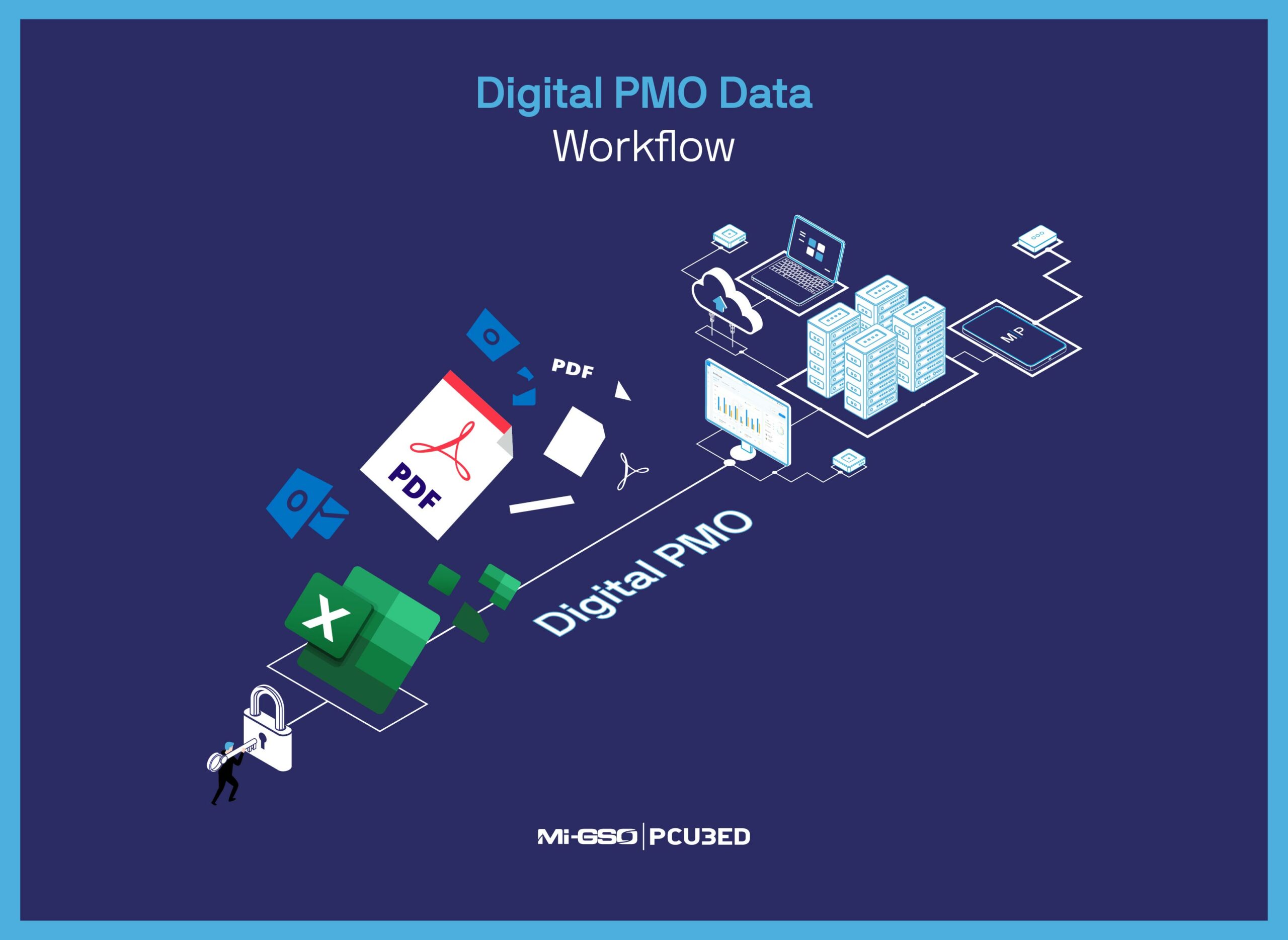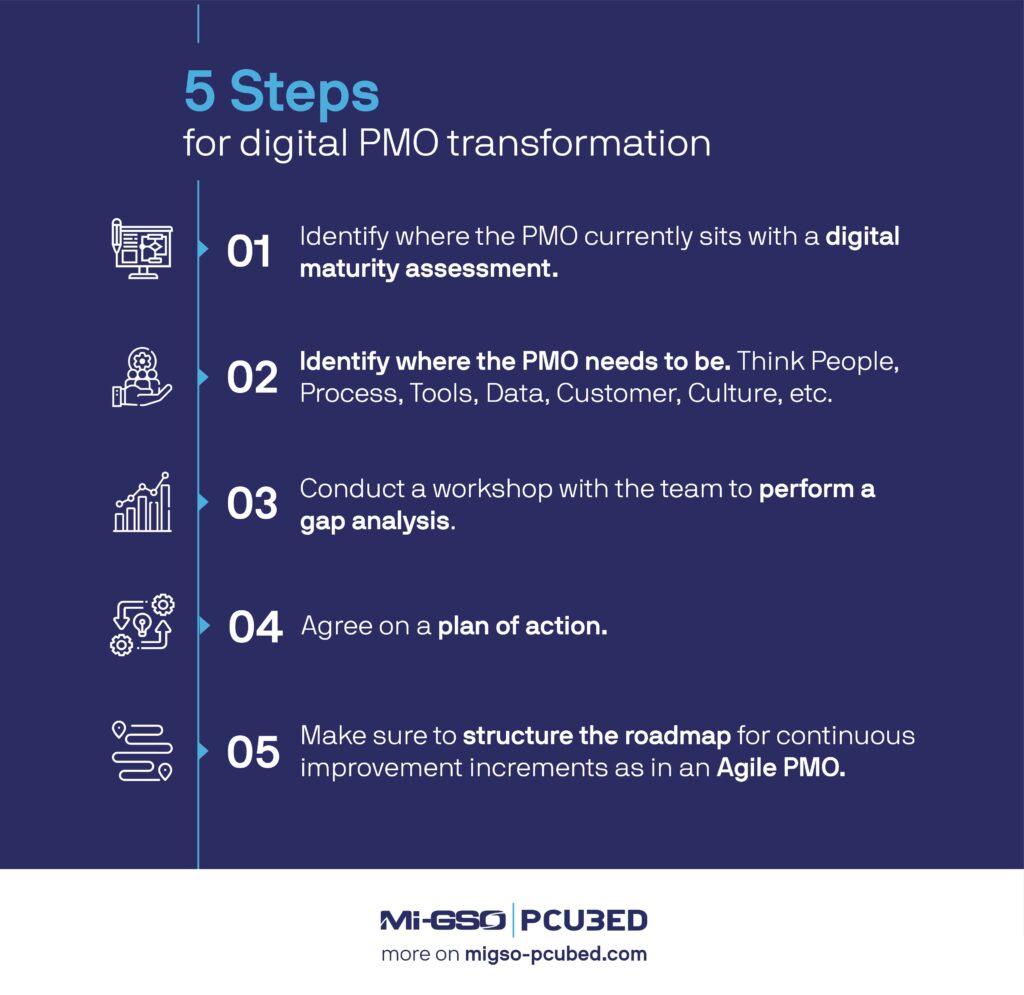An effective PMO, or Project Management Office, is at the heart of any project, acting as a key enabler in its success. It facilitates communication to ensure all are working towards the same strategic goals. To make this feasible, digital is at the core of today’s successful PMO.
A digital PMO is a project management office (PMO) that, thanks to new digital tools and technology enhancements, digitizes and presents information to stakeholders. It’s based on real-time data that can be gathered at the touch of a button.
Because it’s all online, a digital PMO dashboard can be accessed on any device. This has been a godsend with the onset of work from home.
It is a classic PMO that masters digital project management tools bringing value and enhanced customer experience to its teams. We’re not talking about just Excel here – Power BI, Tableau, Qlik, and other platforms are in the mix as in the image below.


The digital project management office is about data processing and analysis coupled with automation. A classic PMO spends around 45% of their time collecting, checking, and compiling data. A digital PMO shifts that effort to defining data mining strategies. Reducing what used to take 45% of your time down to 15% allows you to spend more time on analysis.
“Digital is at the core of today’s successful PMO.”
By building automated dashboards, project managers can keep their stakeholders and teams in the loop while refocusing their efforts on delivering more value instead of report creation. Think of a classic PMO combined with data analysts and data scientists. That’s a good mental model of the digital PMO.
You may be asking yourself why you need a digital PMO. While the digital age has brought us data, it has also brought us too much data. In many organizations, the time has passed to start analyzing and exploiting this data. The classic PMO needs to evolve.

“The more relevant that you want to be, the more data you need in different areas,” Julian explains in his Augmented PMO video interview below. “Project management is not just time management. It’s the integration of the scope, cost, time, resources, stakeholders, communications, quality, risks.
“So, there’s an enormous amount of data that we’re going to have to correlate. We’re not able to do that off the top of our heads. We need a platform, software, something that will allow us to correlate all this data and add value.
And that is the crux. In a 2015 PMI article, they state that “a key challenge is that the integration of new and legacy platforms requires careful thought and planning.” This requires more than just time to set things up. You need a skill set in digital technologies that many classic PMO resources do not have.
It requires a digital-first mindset. You need to be focused on integrating various data points to influence decision-making and improve project performance.
A digital-first mindset uses those gains in time savings from automation and connectivity to focus on analytics. Here are some questions you should be asking:
In early 2019, we created the Digital Lab to meet the growing need for data exploitation within our customer engagements. Gaël Guéguen, the Digital Lab Manager, explained why it matters so we can introduce new value to our clients.
“In the last few years, the volume of information available has skyrocketed,” said Gaël. “This presented both a technical and organizational challenge, but also an opportunity to manage our projects more efficiently.”
The business environment is the most important. It is essential that the company is open to digitization and that key departments, IT for example, are ready to support the PMO in its digital transformation. Without those two things, it will be impossible to find the resources necessary for your PMO to evolve.
Digital maturity is a marathon, not a sprint. You don’t become a digital PMO overnight. It requires structure as you would any other PMO improvement program.
In our recent case study on Digital Transformation, we highlighted that the first step was to agree on the vision for the program. Once the client agreed to the vision for the future, the team then collaborated on a comprehensive program roadmap.

The most common blocking points are that the harmonization of tools and data may not be done yet. The company must be at a level of maturity between its production and its tools to process its data optimally. Without data, there is no PMO.
Centralized tools and enhanced communication between departments is vital for cross-program dashboards to be relevant. Data compliance can be a sticking point if departments do not use the data in the same way. Garbage data in, garbage data out.
Finally, you might think that high-sensitivity data is a limit, but the digital tools on the market today all have the same rigor regarding data security. Data privacy should not be considered a deterrent in digitizing your PMO.
If you haven’t kicked off your journey to a more Digital PMO yet, we encourage you to do so at your earliest convenience. To support you on your journey, we offer you three tips, courtesy of a conversation with Rich Weller, PM artificial intelligence enthusiast:
Research the latest technology on the market and how you can capitalize on its unique benefits within your technology landscape. Be curious. A quick Google search with give you a plethora of ideas on how to incorporate technology like Power Automate, or to use tools like Zapier or IFTTT to integrate your data stack.
Remember the game Tetris? For all you Gen Z folks look it up. Basically you need to anticipate what’s coming down the pipe and how can you continually incorporate or integrate it in to what you have already in place without overwhelming your current landscape.
Use every opportunity to capture your data electronically, in a consistent format, and to store it so that it can be leveraged for making decisions. Then, look at how you can automate your processes to take manual data entry or manipulation out of the your daily work.
“A digital PMO leverages intelligent automation to make improvements in processes and decision making,” said Rich.
“Thanks to the continued proliferation of digital tools, it’s possible to increase the daily performance of our teams by limiting the time needed to collect, structure, and visualize key data”
We combine our expertise with a fine knowledge of the industry to deliver high-value project management services.
MIGSO-PCUBED is part of the ALTEN group.
Find us around the world
Australia – Canada – France – Germany – Italy – Mexico – Portugal – Romania – South East Asia – Spain – Switzerland – United Kingdom – United States
© 2024 MIGSO-PCUBED. All rights reserved | Legal information | Privacy Policy | Cookie Settings | Intranet
Perfect jobs also result from great environments : the team, its culture and energy.
So tell us more about you : who you are, your project, your ambitions,
and let’s find your next step together.
Dear candidates, please note that you will only be contacted via email from the following domain: migso-pcubed.com. Please remain vigilant and ensure that you interact exclusively with our official websites. The MIGSO-PCUBED Team
Choose your language

A monthly digest of our best articles on all things Project Management.
Our website is not supported on this browser
The browser you are using (Internet Explorer) cannot display our content.
Please come back on a more recent browser to have the best experience possible
